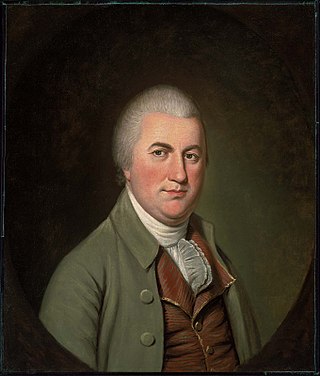
William I was king of the Netherlands and grand duke of Luxembourg from 1815 until his abdication in 1840.

Nathaniel Gorham was an American Founding Father, merchant, and politician from Massachusetts. He was a delegate from the Bay Colony to the Continental Congress and for six months served as the presiding officer of that body under the Articles of Confederation. He also attended the Constitutional Convention, served on its Committee of Detail, and signed the United States Constitution.

The Duchy of Anhalt was a historical German duchy. The duchy was located between the Harz Mountains in the west and the River Elbe and beyond to the Fläming Heath in the east. The territory was once ruled by the House of Ascania, and is now part of the federal state of Saxony-Anhalt.

The history of Saxony-Anhalt began with Old Saxony, which was conquered by Charlemagne in 804 and transformed into the Duchy of Saxony within the Carolingian Empire. Saxony went on to become one of the so-called stem duchies of the German Kingdom and subsequently the Holy Roman Empire which formed out of the eastern partition of the Carolingian Empire. The duchy grew to become a powerful state within the empire, ruling over much of what is now northern Germany, but following conflicts with the emperor it was partitioned into numerous minor states, including the Principality of Anhalt, around the end of the 12th century and early 13th century. The territories of the Duchy of Saxony, the Principality of Anhalt, and their successors are now part of the modern German state of Saxony-Anhalt.

Christian August, Prince of Anhalt-Zerbst was a German prince of the House of Ascania, and the father of Catherine the Great of Russia.

The Kingdom of Prussia was a kingdom that constituted the German state of Prussia between 1701 and 1918. It was the driving force behind the unification of Germany in 1866 and was the leading state of the German Empire until its dissolution in 1918. Although it took its name from the region called Prussia, it was based in the Margraviate of Brandenburg. Its capital was Berlin.

Prince Frederick Henry Louis of Prussia was a Prussian general, statesman, and diplomat. He was a son of King Frederick William I of Prussia and Princess Sophia Dorothea of Hanover, and the younger brother of Frederick the Great. Prince Henry led Prussian armies in the Silesian Wars and the Seven Years' War, having never lost a battle in the latter. In 1786, he was suggested as a candidate to be a monarch in the United States.

Leopold I, Prince of Anhalt-Dessau was a German prince of the House of Ascania and ruler of the principality of Anhalt-Dessau from 1693 to 1747. He was also a Generalfeldmarschall in the Prussian army. Nicknamed "the Old Dessauer", he possessed good abilities as a field commander, but was mainly remembered as a talented drillmaster who modernized the Prussian infantry.

Anhalt-Köthen was a principality of the Holy Roman Empire ruled by the House of Ascania. It was created in 1396 when the Principality of Anhalt-Zerbst was partitioned between Anhalt-Dessau and Anhalt-Köthen. The first creation lasted until 1562, when it fell to Prince Joachim Ernest of Anhalt-Zerbst, who merged it into the reunited Principality of Anhalt.

Anhalt-Bernburg was a principality of the Holy Roman Empire and a duchy of the German Confederation ruled by the House of Ascania with its residence at Bernburg in present-day Saxony-Anhalt. It emerged as a subdivision from the Principality of Anhalt from 1252 until 1468, when it fell to the Ascanian principality of Anhalt-Dessau. Recreated in 1603, Anhalt-Bernburg finally merged into the re-unified Duchy of Anhalt upon the extinction of the line in 1863.
The state of Prussia developed from the State of the Teutonic Order. The original flag of the Teutonic Knights had been a black cross on a white flag. Emperor Frederick II in 1229 granted them the right to use the black Eagle of the Holy Roman Empire. This "Prussian Eagle" remained the coats of arms of the successive Prussian states until 1947.

The Principality of Anhalt was a State of the Holy Roman Empire, located in Central Germany, in what is today part of the federal state of Saxony-Anhalt.

Anhalt-Zerbst was a principality of the Holy Roman Empire ruled by the House of Ascania, with its residence at Zerbst in present-day Saxony-Anhalt. It emerged as a subdivision of the Principality of Anhalt from 1252 until 1396, when it was divided into the principalities of Anhalt-Dessau and Anhalt-Köthen. Recreated in 1544, Anhalt-Zerbst finally was partitioned between Anhalt-Dessau, Anhalt-Köthen, and Anhalt-Bernburg in 1796 upon the extinction of the line.

Joanna Elisabeth of Holstein-Gottorp was a member of the German House of Holstein-Gottorp, a princess consort of Anhalt-Zerbst by marriage, and the regent of Anhalt-Zerbst from 1747 to 1752 on behalf of her minor son, Frederick Augustus. She is best known as the mother of Empress Catherine the Great of Russia.

Ethnic Germans served on both sides of the American Revolutionary War. Large numbers of Germans had emigrated to Pennsylvania, New York, and other American colonies, and they were generally neutral. Some belonged to pacifist sects such as the Amish, but many were drawn into the Revolution and the war.

Frederick Augustus, Prince of Anhalt-Zerbst, was a German prince of the House of Ascania and the last ruler of the Principality of Anhalt-Zerbst.

Alexius Frederick Christian of Anhalt-Bernburg, was a German prince of the House of Ascania. From 1796 until 1807 he was Reigning prince of the principality of Anhalt-Bernburg, and from 1807 until 1834 the first Duke of the Duchy of Anhalt-Bernburg.
Events from the year 1871 in Germany.
Monarchism in the United States is the advocacy of a monarchical form of government in the United States of America. During the American Revolution a significant element of the population remained loyal to the British crown. However, aside from a few considerations in the 1780s, since independence there has not been any serious movement for an American monarchy.
















